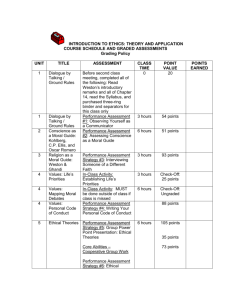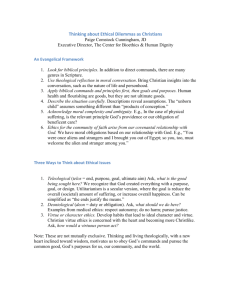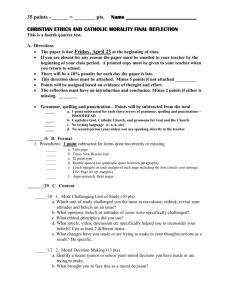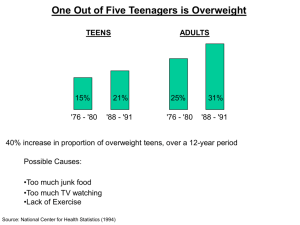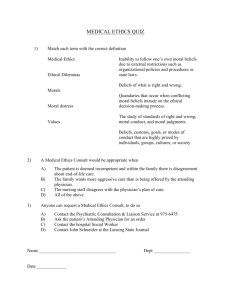Fall Semester Final – MC Paradox
advertisement
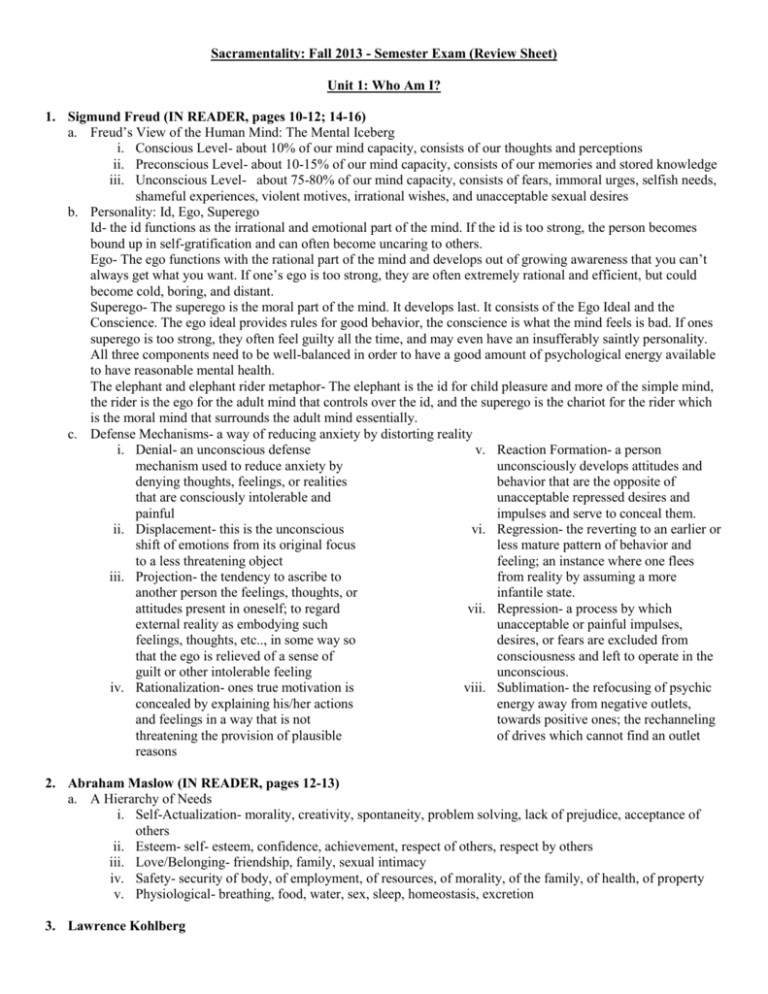
Sacramentality: Fall 2013 - Semester Exam (Review Sheet) Unit 1: Who Am I? 1. Sigmund Freud (IN READER, pages 10-12; 14-16) a. Freud’s View of the Human Mind: The Mental Iceberg i. Conscious Level- about 10% of our mind capacity, consists of our thoughts and perceptions ii. Preconscious Level- about 10-15% of our mind capacity, consists of our memories and stored knowledge iii. Unconscious Level- about 75-80% of our mind capacity, consists of fears, immoral urges, selfish needs, shameful experiences, violent motives, irrational wishes, and unacceptable sexual desires b. Personality: Id, Ego, Superego Id- the id functions as the irrational and emotional part of the mind. If the id is too strong, the person becomes bound up in self-gratification and can often become uncaring to others. Ego- The ego functions with the rational part of the mind and develops out of growing awareness that you can’t always get what you want. If one’s ego is too strong, they are often extremely rational and efficient, but could become cold, boring, and distant. Superego- The superego is the moral part of the mind. It develops last. It consists of the Ego Ideal and the Conscience. The ego ideal provides rules for good behavior, the conscience is what the mind feels is bad. If ones superego is too strong, they often feel guilty all the time, and may even have an insufferably saintly personality. All three components need to be well-balanced in order to have a good amount of psychological energy available to have reasonable mental health. The elephant and elephant rider metaphor- The elephant is the id for child pleasure and more of the simple mind, the rider is the ego for the adult mind that controls over the id, and the superego is the chariot for the rider which is the moral mind that surrounds the adult mind essentially. c. Defense Mechanisms- a way of reducing anxiety by distorting reality i. Denial- an unconscious defense v. Reaction Formation- a person mechanism used to reduce anxiety by unconsciously develops attitudes and denying thoughts, feelings, or realities behavior that are the opposite of that are consciously intolerable and unacceptable repressed desires and painful impulses and serve to conceal them. ii. Displacement- this is the unconscious vi. Regression- the reverting to an earlier or shift of emotions from its original focus less mature pattern of behavior and to a less threatening object feeling; an instance where one flees iii. Projection- the tendency to ascribe to from reality by assuming a more another person the feelings, thoughts, or infantile state. attitudes present in oneself; to regard vii. Repression- a process by which external reality as embodying such unacceptable or painful impulses, feelings, thoughts, etc.., in some way so desires, or fears are excluded from that the ego is relieved of a sense of consciousness and left to operate in the guilt or other intolerable feeling unconscious. iv. Rationalization- ones true motivation is viii. Sublimation- the refocusing of psychic concealed by explaining his/her actions energy away from negative outlets, and feelings in a way that is not towards positive ones; the rechanneling threatening the provision of plausible of drives which cannot find an outlet reasons 2. Abraham Maslow (IN READER, pages 12-13) a. A Hierarchy of Needs i. Self-Actualization- morality, creativity, spontaneity, problem solving, lack of prejudice, acceptance of others ii. Esteem- self- esteem, confidence, achievement, respect of others, respect by others iii. Love/Belonging- friendship, family, sexual intimacy iv. Safety- security of body, of employment, of resources, of morality, of the family, of health, of property v. Physiological- breathing, food, water, sex, sleep, homeostasis, excretion 3. Lawrence Kohlberg a. The Stages of Moral Development i. Level One: Pre-Conventional Morality (“Me” – Individual) 1. Stage One: Punishment and Obedience Something is “wrong” because if I do it, I will be punished Morality is seen as something external to the self People at this stage are dominated by those stronger or in authority. 2. Stage Two: Personal Usefulness Everything is relative to the individual Everyone has the freedom to pursue his or her individual interests. What is “right” is dictated by one’s own personal self interest ii. Level Two: Conventional Morality (“Us” – Group) 3. Stage Three: Conforming to the Will of the Group Looks at the motives behind the act. If one’s intentions in doing a specific act is “good,” i.e., an intention that is going to build up relationships, then it is a “good” act. Furthermore, if the act makes someone appear to be the “nice” boy or girl, then the act is met with approval. At this stage, people conform to group standards in order to gain group approval 4. Stage Four: Law and Order At this stage, the emphasis is on obeying laws, respect of authority, and performing one’s duties, so that the social order is maintained. iii. Level Three: Post-Conventional Morality (“Everybody” – Universal) 5. Stage Five: Social Contract, Constitutionalism, and Higher Law Perons in this stage as the question, “what is a good society?” At this stage, a “good” society is defined as one in which people freely work toward the benefit of all. A society that respects basic human rights and employs democratic means for changing unfair laws and/or improving society as a whole. There comes a recognition that morality and human rights are sometimes more important than laws (civil disobedience, anti-legalism). 6. Stage Six: Personal Conscience It is at the sixth and final stage that justice can be achieved, as this stage is rooted in the basic dignity of all people as individuals. At this stage, justice is understood as a universal, meaning that its related principles apply to ALL people Unit 2: Why Am I Here? 1. Dan Gilbert – “The Surprising Science of Happiness” a. Natural Happiness VS. Synthetic Happiness Natural Happiness- is essentially what we get when we get what we wanted Synthetic Happiness- is essentially what we make when we don’t get what we wanted. 2. “Broaden Your Perspective” a. Habits That Hinder Thinking i. Mine-Is-Better- this stems from believing in the inherent superiority of whatever we associate with ourselves, as an expression of our ego. ii. Face Saving- characterized by an attempt to protect our image after we have said/done something that threatens to disturb either the impression we have of ourselves or that others have of us iii. Resistance to Change- characterized by “the tendency to reject new ideas and new ways of seeing or doing without examining them fairly.” iv. Conformity- we often “find ourselves saying and doing not what we believe is best, but what we believe others want or expect us to say and do.” v. Self-Deception- this stems from the human mind’s “willful and destructive forgetting of whatever in its past does not flatter or confirm its present point of view.” 3. Utilitarianism (“An Introduction to Catholic Ethics,” pages 62-71; IN READER, pages 50-51) a. Three Basic Tenets of Utilitarianism i. The Principle of Utility- Utilitarian notion that, “when a person has a variety of options in a given moral situation, the right choice is the one that results in the greatest amount of happiness for the greatest number of people. ii. Hedonism- Utilitarianism defines happiness as “pleasure and the absence of pain” iii. The Viewpoint of a Disinterested and Benevolent Spectator- to avoid personal bias when making a moral decision. 4. Michael Himes – “Sacramental Vision” (IN READER, pages 55-61) a. Verbum- because we do not speak God’s language, Jesus of Nazareth serves as the translation of God’s verbum in human terms b. Grace- refers to God’s gift of God’s self (God’s self-gift of love) outside the Trinity, which, according to Himes, brings the universe into existence. c. Sign VS. Symbol VS. sacrament (Lower-Case) VS. Sacrament (Upper-Case) Sign- an arbitrary pointer to something else, with no intrinsic connection to what it represents, such as a red octagon indicating that a driver should stop. Symbol- an external/outward expression rooted in what it points to, expressing something within its own depth that cannot be expressed in any other way, such as a hug. Sacrament (lower case)- any person, place, thing, or event who/which gets us to notice, accept, and celebrate God’s love, which is always present in our lives d. Eros VS. Agape/Caritas Eros- Greek for romantic love, also indicates our basic desire to love another and feel connected to another person (love as feeling) Agape- Greek for selfless love, describes loving someone for what he/she needs and desires, to for how I feel or how he/she makes me feel by loving him/her (love as choice) e. The Sacramental Principle- maintains that what is always and everywhere true, must be noticed, accepted, and celebrated somewhere, sometime. Stated negatively, this same notion holds that that which is always and everywhere present, such as God’s love, is easily ignored and taken for granted. f. I-It VS. I-Thou I-It- characterized by seeing others as existing only to the extent that they can be tools utilized to meet my ends I-Thou- characterized by seeing others as true others, without reference to the roles they potentially can play or actually do play in my life 5. C. S. Lewis – “Meditation in a Toolshed” a. Looking At VS. Looking Along Looking at- this is the more secular perspective of looking at things. This takes a more scientific and logical view towards things. People who look at things more think with a lot more reasoning Looking along- These people have a more sacred perspective of looking at things. They base their thoughts a lot more off of faith rather than science and reason. 6. “The Big Patterns That Are Always True” (IN READER, pages 62-65) a. The Monomyth of the Hero 1. Separation from business as usual, old roles, feminine affirmation, etc.. 2. This moves the initiate, hopefully, into a “threshold space” 3. Here a numinous encounter is possible, desired, and required 4. Now the initiate returns to his community with a new identity and a gift for the community, although his primary gift is the man he has become b. The Five Essential Messages of Initiation 1. Life is hard 2. You are not that important 3. Your life is not about you 4. You are not in control 5. You are going to die 7. C. S. Lewis – “Man or Rabbit?” a. Christian VS. Materialist Christian- spiritualist- What’s true? Materialist- secular- What’s helpful? b. Man VS. Rabbit 8. Walter Wink – “The Powers That Be” a. The Ancient Worldview- there is a direct link between heaven and earth’ greek myth b. The Spiritualist Worldview- earth is prison for the bad spirits, heaven is for the good. c. The Materialist Worldview- all you get is earth d. The Theological Worldview- there are two realms, they are both here, and they are separate e. An Integral Worldview- everything is in God, God is in everything; Heaven and earth is together Unit 3: What, If Anything, Am I Supposed To Do? Unit 3 Essential Questions 1. If I do care, as a ____________, what do I need to do? 2. Who’s to say? Why can’t I do whatever I want? 3. Who can tell me what good or bad is? How can anyone? How can I even tell what good or bad is? 4. When will I be grown up? And why are grown ups so messed up? Theorists/Theories/Readings 1. “What Is Ethics?” a. What “Ethics” IS NOT and why (FOUR Things). b. What “Ethics” IS and why (TWO Things). c. Ethics VS. Catholic Ethics (“An Introduction to Catholic Ethics,” Pages 3-5) 2. Relativism (“An Introduction to Catholic Ethics,” Pages 9-19) a. Relativism (Personal Moral Relativism AND Cultural Moral Relativism) b. Appealing Facets of Relativism- there are NO moral rules that apply to all people in one culture. And no one country or person should impose their moral beliefs on others. i. No Science, No Knowledge ethics does not provide a specific answers like ones from science, different circumstances use either science or ethics. We do not choose marriage partners based on science. ii. Circumstances Do Make a Difference Different cultures, people, religions make different moral decisions. iii. Tolerance and Compassion Christian faith is build on this idea. Similar to teaching to Relativism c. Unappealing Facets of Relativism i. Self-Contradictory One part of the statement is opposite of the other. 1 There are no moral rules that are universal. 2 It is wrong for anyone to judge anothers culture based on its own ii. Impracticable It commits the relativist to actions or attitudes that no sane person could carry out or uphold d. Different Cultures, Different Moral Rules? Many different cultures 3. Freedom (“An Introduction to Catholic Ethics,” Pages 123-130) a. Popular Definition (Freedom of speech) VS. Theological Definition (Free Will- power to make free decisions) b. License(American Freedom) VS. Freedom( power to make decisions by God) c. Philosophies That Oppose the Notion of Freedom i. Determinism The philosophical position which maintains “that human actions are dictated by and can be predicted from the laws of nature” ii. Conditioning- Conditioning a response form another thing (happiness-coke) Behaviorism-General understanding of human actions 1. Classical Conditioning - Ivan Pavlov- Dogs salivary glands 2. Operant Conditioning - B. F. Skinner- Skinner Box iii. Principle of Contradiction- “no thing can, at the same time, be both X and not-X in the same way” iv. Practical Refutation- In practice it is impossible to carry out 4. Media/Advertising as Conditioning/Behaviorism a. “The Golden Dawn of Total Advertising” i. The Self-Improvement Pitch- you have this problem and this product is the only one that can fix ii. Snob Appeal- Higher class people that are better than you have it,so to be like them buy this it product iii. Cheesecake in the Ads-kate upton “General Principles in Media Literacy” i. All media are constructions.- Presents a PERFECT reality ii. The media construct reality.-Constructs within our heads a notion of real iii. Audiences negotiate meaning in media.- Messages are not always perceived the same way iv. Media have commercial implications.- It is a business that must make a profit v. Media contain ideological and value messages (Ideology). - Sets a sense of what the general public thinks is normal vi. Media have social and political implications.- Powerfully transmit values and morals vii. Form (artistic/aesthetic) and content (educational/informational) are closely related in media.- Different experiences based on different form and content viii. Each medium has a unique aesthetic form.- Uniques forms portray different messages. c. “The Merchants of Cool: A Report on the Creators & Marketers of Popular Culture for Teenagers” i. Cool Hunting/Culture Spies AND Trendsetters/Early Adopters) 1. search for a player in a specific market 2.able to penetrate communities that larger corporations cannot. 3. person that has the authority to start a new thing and have it stick. ii. Under-the-Radar Marketing- marketing while not seeming like they are marketing iii. The Merchants of Cool Viacom, Disney, Time Warner iv. The Mook/The Midriff- Mook- Jackass, huge character, connects with teens, imature Midriffpremature, developed, all about her body, sexual in nature v. The Giant Feedback Loop- Media watches kids mirrors them, then kids mirror media. 5. Aristotle (“An Introduction to Catholic Ethics,” Pages 27-45) a. Character- Attitudes, dispositions, and opinions, that result in fairly set patterns of acting and reacting b. The Parts of a Human Being i. Rational- Judges right and wrong, makes decisions ii. Non-Rational: Appetitive controls emotions - sexual desires, anger, and pity and Vegetative controls the involuntary functions, breathing, c. Habituation: Virtue(s) and Vice(s) Virtues- how to make the correct decision and feel or desire the appropriate way. Vices- the two decisions that flank the virtuous one d. The FOUR Major Character Types 1.able to judge right from wrong 2.In line with reason 3. Do the right thing i. Virtuous yes, yes, yes ii. Continent/Enduring Yes, no Yes iii. Incontinent/Soft Yes, no, no iv. Vicious/Self-Indulgent no, yes, no e. The Golden Mean- Aristotle’s belief that nearly every “virtue” is the intermediate course between two extremes, namely the “vice” of excess and the “vice” of deficiency f. Know Yourself- Avoid the vices that we are particularly prone g. The Bent Stick Remedy- to change actions you must do the complete opposite 6. “Right or Wrong: How Can I Know?” a. Goodness Freedom- when you focus on others you become more free than when you only focus on yourself b. Badly-Formed Consciences-Wrong i. Guilty Conscience- contently feels guilty about everything even things that are outside of his control b. ii. iii. Flabby Conscience-lax or loose conscience that causes her to think everything is ok Rationalizing Conscience-she knows what is wrong and right however rationalises her actions to be right iv. Legalistic Conscience-he does what he is told however is not very loving he is almost on a point system 7. “What Is Virtue?” a. “Values” (Subjective/Relative) VS. “Virtues” (Objective/Universal) b. FOUR Classical Virtues: i. Prudence-wisdom- making the right decision in an array of scenarios ii. Justice-fairness, honesty, and keeping promises iii. Fortitude-courage and guts, bravery to enter the unknown iv. Temperance-self control over pleasures 8. What Difference Does God Make To The Good? (“An Introduction to Catholic Ethics,” Pages 89-99) a. Natural Law-the notion, maintained by the Catholic Church, that “God has given to all men and women the natural ability to discover what is right and wrong using their reason alone” b. Natural Virtues-“Good Habits” which “perfect the purely human part of our nature” c. Theological Virtues-“Good Habits” which “prepare and perfect the divine part of our nature” i. Faith we believe in God and believe all that he has said and revealed to us, and that the Holy Church proposes for our belief” ii. Hope we desire the kingdom of heaven and eternal life as our happiness, placing our trust in Christ’s promises and relying not on our own strength, but on the help of the grace of the Holy Spirit” iii. Charity-which we love God above all things for his own sake, and our neighbor as ourselves for the love of God” d. Anonymous Christians-“people from non-Christian religions, as well as people with no religious affiliation at all” who “often do what God’s Law commands even though they do not acknowledge or realize that that is what they are doing” 9. “The Day of the Rabbit” (IN READER, Page 66) a. The Master-God, reason, conscience faith- she will change, hope- hope she will change, charity- loves her the whole time b. Gypsy-vicious person, licence c. Flurry-virtuous person 10. Immanuel Kant (“An Introduction to Catholic Ethics,” Pages 46-61) a. Kant VS. Aristotle b. A Good Will- Kant viewed this as a humans telos c. Deontology- kants believes, grounded in reason, follow the law for the law itself d. Categorical Imperatives (General)/The Categorical Imperative (Specific) i. The Formula Of Universal Law-we should be able to conceive with our reasoning as a universal law and will that our reasoning should become universal law ii. The Formula Of The End In Itself-a true reflection of much of our moral language 11. “Building Your Own Conscience” (IN READER, Pages 45-49) a. Opinion (Subjective/Secondary Truth) VS. Evidence (Objective/Primary Truth) b. Epistemology- study of knowledge and trust c. What Are Humans For? i. Mineral- can’t reproduce ii. Vegetable- can't feel iii. Animal- can’t reason iv. Human- can’t sacrifice 1. Can Understand- can understand differences 2. Can Love Unselfishly- I want you happy even if that does make me unhappy 3. Can Grow More Human-can become a more loving caring being 12. Philip Zimbardo – “The Psychology of Evil” a. Evil (Psychological Definition)- an exercise of power to purposely harm or hurt b. Stanley Milgram’s Experiment- 3 people experimenter, learner, teacher shocked if answered wrong, worked up until the XXX level. c. Stanford Prison Study- 12 prisoners, 12 guards, no bad apples, turned on each other, prisoners had emotional breakdowns d. THREE Factors That Contribute To Evil: i. Dispositional: “The Bad Apples.”- inside the individual ii. Situational: “The Bad Barrel.”-external influence iii. Systemic: “The Bad Barrel-Makers.”- influences, political, economic, legal power e. THREE Possible Responses To Evil: i. Perpetrator of Evil.- stanford prison study, for no reason becoming evil ii. Passive Inaction.- stepping back not to intervene iii. Hero.- good apple most people will follow 13. “Mississippi Burning” 14. Conscience (“An Introduction to Catholic Ethics,” Pages 141-152) a. Conscience i. Capacity of Conscience-everyone has the power to make decisions about good and evil ii. Process of Conscience- process of reaching the decision about the good and evil iii. Judgment of Conscience- final conclusion if something is good or bad b. Responsibility (Objective) VS. Culpability (Subjective) c. “Fonts of Morality”/The Parts of a Moral (or Immoral) Act i. Act-In-Itself/Object-what you have chosen to do ii. Intention-what you have chosen to do to the object iii. Context/Circumstances-a) the person who is performing the action, b) the context of the action itself d. What Conscience Is Not i. Majority Opinion- these are people that believe the popular decision is the right one ii. Feeling- these people count on only what they feel is right iii. Superego- does not give the sufficient space to make judgements based on conscience iv. Gut-Instinct- quick decisions that do not complete the steps of conscience v. “Jiminy Cricket”- an eternal voice, a separate person telling us what to do vi. Myth- a conscience does not exist Unit 4: Life Issues 1. “Poverty of Spirit” (IN READER, pages 85-89) a. What characterizes our humanity? To become a man is to become poor. Without support and without power b. What is sin? Sin is us trying to portray or be above God c. How can it be said that Christ experienced humanity more fully than anyone else ever has or ever could? He devoted a life to poverty, and at the end of his life, he was given no support and no power anymore from people 2. Euthanasia/Assisted Suicide a. Euthanasia- The intentional ending of a life, by design or by omission, of a person whose life has been deemed not worth continuing. b. Assisted Suicide- Base on the belief that a person, generally someone who is terminally ill or who is being kept alive by artificial means, should be able to end his or her life by means of taking a lethal dose of some drug with the aid of a physician. c. Active VS. Passive- “Mercy Killing,” Active- involves the attempt to bring about the death of a person by means of a death-producing agent or procedure Passive- “Euthanasia by omission,” The intentional avoidance or discontinuance of steps to prolong life d. Voluntary VS. Involuntary Voluntary- The clinical termination of the life of a patient who, being of sound mind, but who has become the victim of debilitating illness or disease, requests that such termination be carried out. Involuntary- Proceeds without the Informed Consent of the patient because he or she is deemed incapable of assisting in the decision-making process. e. Informed Consent- the act of agreement on the part of an individual to a procedure that is understood to be so farreaching in its potential consequences that the inclusion of the individual is mandated. Requires that the person be given appropriate and adequate information as to the nature, benefits, and possible risks involved with, as well as alternatives to, the procedure. f. Ordinary Means/Proportionate Means VS. Extraordinary Means/Disproportionate Means g. What is the Catholic Church’s stance on Euthanasia/Assisted Suicide and why? The church believes that euthanasia is wrong because it violates the fact that life is the first right of the human person and the condition of all the others. 3. “Being Human” a. What is the definition of a human person? Pluhap states that humans have potential. A human demonstrates certain capacities. 4. Abortion a. Abortion- any medical procedure that terminates the life of the human embryo or fetus prior to birth b. Embryo- from fertilization/conception to the end of eight weeks gestation c. Fetus- from the first day of the 9th week of gestation until birth d. Ectopic Pregnancy- the fertilized egg attaches to an area outside of the uterus, rather than in the uterus. There is no way to save an ectopic pregnancy, and if left untreated, such a tubal pregnancy can damage or burst the fallopian tube, resulting in heavy bleeding and possible death to the mother e. The Principle of Double Effect- The theory that a moral agent is not to be held morally accountable for unintended and perhaps unavoidable ill side effects of an action or series of actions that is otherwise morally legitimate. In cases where a contemplated action has both good effects and bad effects, the action is permissible only if it is not wrong in itself and if it does not require that one directly intend the evil result. There are four conditions in which an action in question may be permissible. The action contemplated must be in-itself either morally good or morally indifferent The bad result must not be directly intended The good result must not be a direct casual result of the bad result The good result must be proportionate to the bad result f. What is the Catholic Church’s stance on Abortion and why? The Catholic church definitely rejects abortion because it is also violating the first right to a human, even though the human isn’t born yet. The church considers it still a person, therefore it is impermissible to end the life of it. Essays REMEMBER: A subjective opinion’s claim to be true is only as valid as the objective evidence offered in support. 1. List/explain ONE difference AND ONE similarity between each of the FIVE ethical theories we have studied this semester: Relativism, Utilitarianism (Mill), Teleology (Aristotle), Deontology (Kant), and Catholic Christianity. Relativism vs. Christianity- Both Christianity and Relativism is very tolerant and compassionate. However, relativism goes off the idea, “No Science, No Knowledge,” while Christianity is based off of faith Utilitarianism vs. Christianity- Both ideas definitely deal with consequences on actions. However, in Utilitarianism, if a bad action is done, but it has good consequences, then it is still considered a good action. In Christianity, that never happens, a bad action is a bad action, regardless of consequences. Teleology vs. Christianity- Both ideas have a telos. In teleology, the telos is happiness, in Christianity, the telos is heaven. However, in teleology, if someone is vicious, they stay vicious because that is their telos. In Christianity, there is a forgiving God for change in character. Deontology vs. Christianity- Both have a similar idea. Christianity has the Golden Rule and Deontology has the Universal Law. However, in Christianity, even if the intention is good but an action is bad, it is still a bad action. In Deontology, Kant says that no bad action could have a good intention in the first place. 2. Consider the following words of serial killer Ted Bundy, who confessed to over thirty murders, when interviewed about how he explained his actions to one of his female victims: Then I learned that all moral judgments are “value judgments,” that all value judgments are subjective, and that none can be proved to be either “right” or “wrong.” I discovered that to become truly free, truly unfettered, I had to become truly uninhibited. And I quickly discovered that the greatest obstacle to my freedom, the greatest block and limitation to it, consists in the insupportable “value judgment” that I was bound to respect the rights of others. I asked myself, who were these “others”? Other human beings, with human rights? Why is it more wrong to kill a human animal than any other animal, a pig or a sheep or a steer? Is your life more to you than a hog’s life to a hog? Why should I be willing to sacrifice my pleasure more for the one than for the other? Surely, you would not, in this age of scientific enlightenment, declare that God or nature has marked some pleasures as “moral” or “good” and others as “immoral” or “bad”? In any case, let me assure you, my dear young lady, that there is absolutely no comparison between the pleasure I might take in eating ham and the pleasure I anticipate in raping and murdering you. That is the honest conclusion to which my education has led me—after the most conscientious examination of my spontaneous and uninhibited self. With these words in mind, respond to each of the following questions (Each individual response should incorporate one or more concrete/explicit tie-in(s) to the material covered this semester, which exhibit/demonstrate your understanding of the relevant concepts/terms/readings, as support.): a. Using Mill’s theory and reasoning, how would you respond to the ethical viewpoint espoused by Bundy? b. Using Aristotle’s theory and reasoning, how would you respond to the ethical viewpoint espoused by Bundy? c. Using Kant’s theory and reasoning, how would you respond to the ethical viewpoint espoused by Bundy? d. Using Catholic Christianity’s theory and reasoning, how would you respond to the ethical viewpoint espoused by Bundy? e. What makes any given ethical theory (such as that espoused by Ted Bundy, Mill, Aristotle, Kant, or Catholic Christianity) better or worse than another? NOTE: The terms “better” and “worse” rely on a determination of “good”/“right” and “bad”/“wrong,” so your response should touch on what criteria you are applying to make such a distinction.
